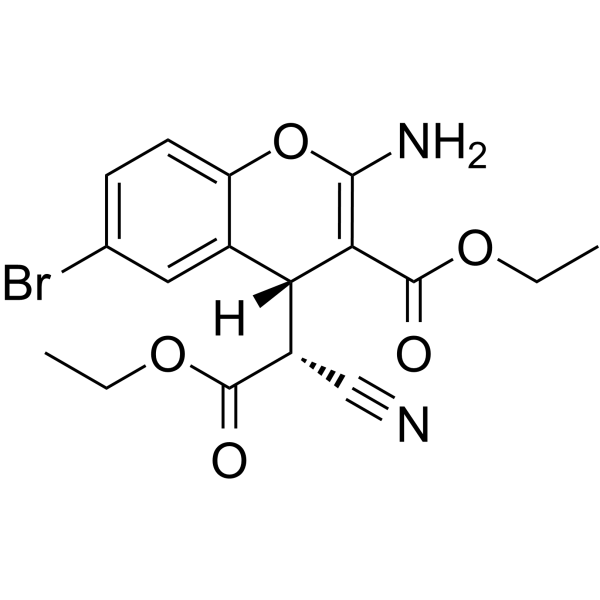上海金畔生物科技有限公司为生命科学和医药研发人员提供生物活性分子抑制剂、激动剂、特异性抑制剂、化合物库、重组蛋白,专注于信号通路和疾病研究领域。
HA14-1 纯度: ≥98.0%
HA14-1 是一种 Bcl-2/Bcl-xL 拮抗剂。HA14-1 与 Bcl-2 上的特定口袋结合, IC50 约为 9 μM,并抑制 Bcl-2 功能。

HA14-1 Chemical Structure
CAS No. : 65673-63-4
| 规格 | 价格 | 是否有货 | 数量 |
|---|---|---|---|
| 10 mM * 1 mL in DMSO | ¥500 | In-stock | |
| 10 mg | ¥400 | In-stock | |
| 50 mg | ¥1252 | In-stock | |
| 100 mg | 询价 | ||
| 200 mg | 询价 |
* Please select Quantity before adding items.
HA14-1 相关产品
•相关化合物库:
- Bioactive Compound Library Plus
- Apoptosis Compound Library
- Anti-Cancer Compound Library
- Anti-Blood Cancer Compound Library
| 生物活性 |
HA14-1 is a Bcl-2/Bcl-XL antagonist. HA14-1 binds the designated pocket on Bcl-2 with the IC50 of ≈9 μM in competing with the Bcl-2 binding of Flu-BakBH3, and inhibits its function. |
||||||||||||||||
|---|---|---|---|---|---|---|---|---|---|---|---|---|---|---|---|---|---|
| IC50 & Target[1][2] |
|
||||||||||||||||
| 体外研究 (In Vitro) |
HA14-1 is a nonpeptidic ligand of a Bcl-2 surface pocket. HA14-1 induces the activation of Apaf-1 and caspases, possibly by binding to Bcl-2 protein and inhibiting its function. The interaction of HA14-1 with the Bcl-2 surface pocket appeared to be specific for the chemical structure of HA14-1 as a series of synthetic analogs derived from HA14-1 containing various modifications are found to have widely different Bcl-2 binding activities. To examine the effect of HA14-1 on cell viability, HL-60 cells are treated with various concentrations of HA14-1 for 4 h. HA14-1 induces the death of HL-60 cells in a dose-dependent manner. At 50 μM, HA14-1 causes the lost of viability in more than 90% of the cells[1]. HA14-1 is a Bcl-2/Bcl-xL antagonist[2]. 上海金畔生物科技有限公司 has not independently confirmed the accuracy of these methods. They are for reference only. |
||||||||||||||||
| 体内研究 (In Vivo) |
Swiss nude mice are challenged with BeGBM cells (104 injected s.c.). HA14-1 (400 nmol) in 100 μL free RPMI 1640-50% DMSO, or the carrier alone, is given at the site of injection once weekly from day 2 following cell injection. HA14-1 treatment does not have any significant effect on the growth of glioblastoma tumors in immunodeficient mice as monitored twice weekly by measuring the volume of the expanding tumors. Moreover, no gross organ toxicity or weight loss can be detected in mice receiving such treatment. To analyze whether HA14-1 treatment might enhance the efficiency of another antitumoral treatment, Swiss nude mice challenged with human glioblastoma multiforme cells are also given i.p. low doses of Etoposide (2.5 mg/kg in 200 μL of 0.9% NaCl 5 days a week from day 2 following cell injection) together with HA14-1 or mock treatment. Whereas Etoposide treatment is insufficient by itself to restrain the growth of glioblastoma cells, its combination with HA14-1 leads to a significant restrain on tumor growth as judged by the ability of the combined treatment to increase the doubling time of the tumor volume[3]. 上海金畔生物科技有限公司 has not independently confirmed the accuracy of these methods. They are for reference only. |
||||||||||||||||
| 分子量 |
409.23 |
||||||||||||||||
| Formula |
C17H17BrN2O5 |
||||||||||||||||
| CAS 号 |
65673-63-4 |
||||||||||||||||
| 运输条件 |
Room temperature in continental US; may vary elsewhere. |
||||||||||||||||
| 储存方式 |
|
||||||||||||||||
| 溶解性数据 |
In Vitro:
DMSO : ≥ 50 mg/mL (122.18 mM) * “≥” means soluble, but saturation unknown. 配制储备液
*
请根据产品在不同溶剂中的溶解度选择合适的溶剂配制储备液;一旦配成溶液,请分装保存,避免反复冻融造成的产品失效。 In Vivo:
请根据您的实验动物和给药方式选择适当的溶解方案。以下溶解方案都请先按照 In Vitro 方式配制澄清的储备液,再依次添加助溶剂: ——为保证实验结果的可靠性,澄清的储备液可以根据储存条件,适当保存;体内实验的工作液,建议您现用现配,当天使用; 以下溶剂前显示的百
|
||||||||||||||||
| 参考文献 |
|
| Kinase Assay [1] |
The binding affinity of organic compounds to Bcl-2 protein in vitro is determined by a competitive binding assay based on fluorescence polarization. For this assay, 5-carboxyfluorecein is coupled to the N terminus of a peptide, GQVGRQLAIIGDDINR, derived from the BH3 domain of Bak (Flu-BakBH3), which has been shown to bind to the surface pocket of the Bcl-xLprotein with high-affinity (dissociation constant, KD, of ≈0.34 μM). According to our molecular modeling studies and binding measurement using fluorescence polarization, the Flu-BakBH3 peptide binds the surface pocket of Bcl-2 with a similar affinity (dissociation constant, KD, of ≈0.20 μM). Bcl-2 used in this assay is a recombinant GST-fused soluble protein. Flu-BakBH3 and Bcl-2 protein are mixed in the presence or absence of organic compounds under standard buffer conditions and are incubated for 30 min. The binding of Flu-BakBH3 to Bcl-2 protein is measured on a LS-50 luminescence spectrometer equipped with polarizers using a dual path length quartz cell (500 μL). The fluorophore is excited with vertical polarized light at 480 nm (excitation slit width 15 nm), and the polarization value of the emitted light is observed through vertical and horizontal polarizers at 530 nm (emission slit width 15 nm). The binding affinity of each compound for Bcl-2 protein is assessed by determining the ability of different concentrations of the compound to inhibit Flu-BakBH3 binding to Bcl-2[1]. 上海金畔生物科技有限公司 has not independently confirmed the accuracy of these methods. They are for reference only. |
|---|---|
| Cell Assay [1] |
The dose-dependent effect of the compounds on the viability of HL-60 cells is tested by using the CellTiter 96AQ kit. In brief, the cell suspension containing 1×105 cells in 100 μL of medium are plated into a 96-well plate and are incubated with compounds (e.g., HA14-1; 10, 20, 30, 40, 50 and 60 μM) at different concentrations. The numbers of apoptotic cells are determined by measuring the optical density on a Wallac Victor counter at 490 nm. Cell viability is also determined by Trypan blue exclusion in a hemocytometer[1]. 上海金畔生物科技有限公司 has not independently confirmed the accuracy of these methods. They are for reference only. |
| Animal Administration [3] |
Mice[3] 上海金畔生物科技有限公司 has not independently confirmed the accuracy of these methods. They are for reference only. |
| 参考文献 |
|
所有产品仅用作科学研究或药证申报,我们不为任何个人用途提供产品和服务
